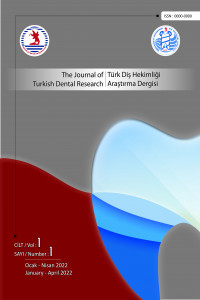‘Deprem Gibi Doğal Afetlerde Uzaktan Eğitim Öğretilen Anatomi Dersinin Diş Hekimliği Öğrencileri Üzerindeki Etkisi’
Amaç: “Deprem gibi doğal afetlerde uzaktan eğitim
anatomi dersinin öğretilmesinde, alternatif bir çözüm olabilir
mi?”sorusunun yanıtını öğrenci görüşleriyle literatüre
kazandırmak bu çalışmanın amacıdır.
Gereç ve Yöntem: Çalışmaya 2022-2023 bahar yarıyılı
diş hekimliği birinci sınıf öğrencilerinden 57 kişi katılmıştır.
Deprem felaketi sonrası uygulanan uzaktan anatomi eğitimi
ile ilgili sorulan sorulara kız ve erkek öğrencilerin verdikleri
cevaplar ki-kare analizi ile karşılaştırılarak bu cevapların
anlamlılığı incelenmiştir.
Bulgular: Araştırmada sorulan 1., 13. ve 15. sorulara
kız ve erkek öğrencilerin verdikleri yanıtların ki-kare testi
kullanılarak karşılaştırılmasında sırasıyla anlamlı bir fark
bulunmuştur (p=0,044, p=0,016, p=0,014).
Sonuç: Ülkemizde yaşanan deprem felaketi (6 Şubat 2023),
uzaktan eğitimin covid-19 pandemisi sonrasında da alternatif
bir çözüm olarak kullanılabileceğini göstermiştir. Pandemi
veya doğal afet gibi durumlar dışında anatomi dersleri için
uzaktan eğitim hibrit eğitimle harmanlanabilir mi? Bu cevabın
öğrenci görüşleri ile desteklenmesi ve literatüre aktarılması
gelecekteki sağlık eğitimini önemli ölçüde etkilemektedir.
Anahtar Kelimeler:
Anatomi eğitimi, diş hekimliği eğitimi, uzaktan eğitim, deprem
‘The Effect of Distance Learning Anatomy Lesson on Dentistry Students in Natural Disasters such as Earthquakes’
Purpose: “Can distance education be an alternative
solution for teaching anatomy lessons in natural disasters such
as earthquakes?” The aim of this study is to bring the answer of
the question to the literature with student opinions.
Material and Method: 57 people from 2022-2023 spring
semester first year dentistry students participated in the study.
The answers given by female and male students to the questions
asked about distance anatomy education applied after the
earthquake disaster were compared with the chi-square
analysis and the significance of these answers was examined.
Results: A significant difference was found in the
comparison of the answers given by male and female students
to the 1st, 13th and 15th questions asked in the study using the
chi-square test (p=0.044, p=0.016, p=0.014, respectively).
Conclusion: The earthquake disaster in our country
(February 6, 2023) has shown the fact that distance education
can still be used as an alternative solution after the covid-19
pandemic. Can distance education be blended with hybrid
education for anatomy lessons, except in cases such as
pandemics or natural disasters? Supporting this answer with
student opinions and passing it on to the literature significantly
affects future health education.
Keywords:
Anatomy education, dentistry education, distance education, earthquake,
___
- Hilburg R, Patel N, Ambruso S, Biewald MA, Farouk SS. Medical education during the coronavirus disease-2019 pandemic: learning from a distance. Advances İn Chronic Kidney Disease. 2020;27:412-7.
- Xalmuratova MT. Advantages and dısadvantages of dıstance learnıng for languages ın medıcal unıversıtıes ın a pandemıc sıtuatıon. Palarch’s Journal Of Archaeology Of Egypt/Egyptology. 2021;18:3965-9.
- Adedoyin OB, Soykan E. Covid-19 pandemic and online learning: the challenges and opportunities. Interactive Learning Environments. 2023;31:863-75.
- Elhaty IA, Elhadary T. Online education in turkish universities after the earthquake: the pros and cons. Journal Of Survey İn Fisheries Sciences, 2023;10:330-340.
- Özer M. Education policy actions by the ministry of national education after the earthquake disaster on February 6, 2023 in Türkiye. Bartin University Journal Of Faculty Of Education. 2023;12.
- Bahşi İ, Topal Z, Çetkin M, Orhan M, Kervancıoğlu P, Odabaşıoğlu ME, Cihan ÖF. Evaluation of attitudes and opinions of medical faculty students against the use of cadaver in anatomy education and investigation of the factors affecting their emotional responses related thereto. Surgical And Radiologic Anatomy. 2021;43:481-7.
- Khan F, Tarimer I, Taekeun W. Factor model for online education during the covıd-19 pandemic using the ıot. processes. 2022;10:1419.
- Shahrvini B, Baxter SL, Coffey CS, Macdonald BV, Lander L. Pre-Clinical Remote Undergraduate medical education during the covıd-19 pandemic: a survey study. BMC Medical Education. 2021;21:1-3.
- Papa V, Varotto E, Galli M, Vaccarezza M, Galassi FM. One year of anatomy teaching and learning in the outbreak: Has the Covid‐19 pandemic marked the end of a centuryold practice? A systematic review. Anatomical sciences education. 2022;15:261-80.
- Turamanlar O, Güzel H. The view of medical students on the anatomy course given by distance education during COVID-19 pandemic. Anatomy.2021;14:202–209. https:// doi.org/10.2399/ana.20.820414
- Yilmaz Y, Sarikaya O, Senol Y, Baykan Z, Karaca O, Demiral Yilmaz N, Altintas L, Onan A, Sayek İ. REAıming covıd-19 online learning for medical students: a massive open online course evaluation. BMC Medical Education. 2021;21:1-4.
- Paudel P. Online education: benefits, challenges and strategies during and after covıd-19 in higher education. International Journal On Studies İn Education (Ijonse). 2021;3.
- Topkaya Ö, Benli A, Cerev G. Online distance learning during covid-19 pandemic: An empirical analysis over the students’ opinions. Journal of Economy Culture and Society. 2021;64:207- 231. https://doi.org/10.26650/ JECS2021-862821
- Amir LR, Tanti I, Maharani DA, Wimardhani YS, Julia V, Sulijaya B, Puspitawati R. Student perspective of classroom and distance learning during covıd-19 pandemic in the undergraduate dental study program universitas ındonesia. BMC Medical Education. 2020;20:1-8.
- Weissmann Y, Useini M, Goldhahn J. COVID-19 as a chance for hybrid teaching concepts. GMS Journal For Medical Education. 2021;38.
- Hameed BZ, Tanidir Y, Naik N, Teoh JY, Shah M, Wroclawski ML, Kunjibettu AB, Castellani D, Ibrahim S, Da Silva RD, Rai B. Will “hybrid” meetings replace faceto- face meetings post covıd-19 era? perceptions and views from the urological community. Urology. 2021;156:52-7.
- Başlangıç: 2022
- Yayıncı: Ondokuz Mayıs Üniversitesi
Sayıdaki Diğer Makaleler
DİŞ HEKİMLİĞİ PRATİĞİNDE SIK KARŞILAŞILAN MAKSİLLER SİNÜSLERİN ENFLAMATUAR HASTALIKLARI: DERLEME
Rümeysa ŞENDİŞÇİ, Selmi YILMAZ
Dens İnvajinatus ile Birlikte Görülen Bifasiyal Talon Tüberkülü: Bir Olgu Sunumu
Diş Çürüğünün Teşhisi ve Bu Amaçla Kullanılan Güncel Yöntemler
COVID-19 Pandemisinin Ağız, Diş ve Çene Cerrahisi Kliniğine Etkileri
